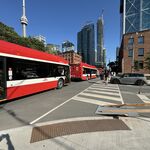Reclaiming unneeded double track is Railroading 101 level business strategy. At low train frequency, double track is a luxury whose capital cost far exceeds any operational gain. If VIA disappeared, CN could remove two-thirds of the second track without affecting operations on that line. The economics of doing so are deafening. Every market analyst would be on their case if they didn't. [...]
Meh, it's not that long a stretch. Railroads are not that hard to build in open terrain, even through Canadian Shield. A few swamps, yes, and some rock blasting/drilling. Precious few people, and most of it is not prime cottage country. The biggest unknown is what mitigation to natural impacts is required. Considering the amount of support for twinning Highway 7 all the way from Tweed to Ottawa - a much more expensive proposition - the rail option ought to be a much easier sell.
You'd better sell your CP shares then before they bankrupt over their Winchester subdivision - an entirely double-tracked line (Dorval - Smith Falls) with no TSA payments extracted from passenger railroads (if we ignore AMT's Vaudreuil-Hudson line, which only uses a very short segment) - irresponsible waste of money, according to your railroading expertise. Also, since road construction and VIA Rail are not eligible for the same funding options, a price tag which is deemed acceptable for a road project might not appeal enough for a rail project. Besides, I don't really have an idea what the Gananoque Bypass would cost, but I'd guess it would be considerably more than the
$500 million figure Greg Gormick pulled out of only he knows where, given that it would work out at a lower per-mile cost than his $150 million quote for restoring the Brantford Bypass.
I'm not sure why you're bringing up the United States, and specifically their two most densely populated corridors. The US has 9 times our population, which means it has 9 times as many potential rail corridors as we do. If we have a handful of routes, they have dozens. So no, it's no more difficult to upgrade the Toronto-Montreal route than it would be to upgrade any one of the many comparable corridors in the States.
No, they're not anomalies, they're well within the range of densities where high speed rail is feasible. France was the first European nation with high speed rail and Spain has the densest network by population. Those two countries are perfectly valid evidence that HSR can work in areas less densely populated than Germany and Japan.
Of course, if we're talking about Via's high frequency rail plan, then we can also look at parts of the world that are much less densely populated and already have that type of service.
If there actually is one thing which is completely arbitrary to derive from population figures, it is the number of potential HSR corridors. Vietnam has about 5 times the population of Chile (90 vs 18 million), but that doesn't change the fact that both are remarkably narrow countries, which have their main cities lined up on one Corridor along their respective coasts.
To determine whether we should count Spain as a success, we need to agree on performance criteria, and I believe that passenger ridership levels and the growth herein should be the benchmarks (to be sure: on a per-capita basis, since we want to make meaningful comparisons between countries of differing scales). Out of the 9 European countries, which had HSR infrastructure in 2013 (i.e. the most recent year for which the
2015 Statistical Yearbook of the European Commission had all figures), Spain had both, the by far highest HSR-density and the worst per-capita ridership in that year, while only Italy had shown worse (actually: negative) passenger growth in the preceding decade:
Also financially, HSR has been a
disaster for Spain, with all of its main corridors being unable to fully recover either their financial or social costs (and in the case of the Northern Corridor: not even able to at least recover its operating costs):
Note: an earlier version of this table showed the years of construction or opening, which caused some confusion.
Furthermore, the
unsustainable boom in HSR construction (and of other,
largely superfluous infrastructure) has been
attributed as having significantly contributed to the countries' deep troubles in the recent debt crisis.
So let's ignore the last few posts and let me answer this
With, "no, I was not talking about Hamilton, I was talking about Brampton."
Shouldn't we move this whole "Brampton vs Hamilton" and "GO RER vs HSR" discussion to the
High Speed Rail: London - Kitchener-Waterloo - Pearson Airport - Toronto thread, where exactly these questions have been discussed repeatedly and extensively?
[...]
What are the frequencies of the HSR? Hourly? Let's assume 1/2 hourly.
What is the trip time from Pearson to London? 2 hours? Let's assume 1 1/2 hours.
[...]
I still maintain my calculations that reducing the travel times
between Toronto and Kitchener to 48 minutes and
Toronto-Kitchener-London to 97 minutes is feasible with the current alignment upgraded to a design speed of 160 km/h. Unless this is helplessly overoptimistic, what exactly is the need to go for HSR? Because for now, it just looks like been born from the misconception that HSR means "any rail service which is faster than VIA" (as we've seen
previously, it is not even necessarily faster than VIA at all)...





